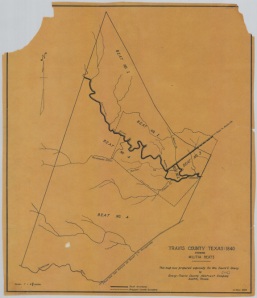The Office of the Justice of the Peace
Thursday, May 20th, 2010 in elected officials. No Comments
The origins of the office of Justice of the Peace extend back to the Middle Ages in England, where the King commissioned knights to preserve peace in unruly areas. Responsible for ensuring that the law was upheld, these knights were known as “keepers of the peace.” The title “Justice of the Peace” originates from an Act of Parliament passed in 1361.
When the American colonies were founded by the British in the 17th century, one of the first offices established was that of the Justice of the Peace, or magistrate, to establish and maintain order among the colonists. The colonial Justice was a person of recognized standing who exercised both criminal and civil jurisdiction, as well as local executive and administrative powers.
In Texas during the days of the Republic, the Justice of the Peace was an integral part of the county government, as both an important judicial officer and an influential political officer. In fact, the chief governing body of the county was the county board, which, up until 1845, was composed of the Chief Justice and elective Justices of the Peace.
Travis County was established by the Republic of Texas Congress on January 25, 1840. Prior to the county’s formation, Chief Justice James W. Smith mapped out four militia beats, each assigned to a militia unit to patrol. These four beats would come to be called precincts, and they were served by Travis County’s first Justices of the Peace: D. Laughlin, B.F. Johnson, S.J. Whatley, and W.Y. Wood.
Precincts were changed often in those early days, both in number and in name. In accordance with the 1836 Texas Constitution, a “convenient number” of Justices of the Peace were elected to help keep the peace, and this number varied from year to year. In 1855, Travis County had as many as 10 different precincts. For a brief time in the 1850s, the precincts were referred to by geographical name rather than by number, such as “Austin Precinct,” “Onion Creek Precinct,” and “Webberville Precinct.”
Throughout the years, changes to the Texas Constitution altered the terms and requirements of the Justice of the Peace office, and precincts were adjusted accordingly by the Commissioners Court.
In 1936, there were six Justice of the Peace precincts, an arrangement that would stand for nearly 40 years. As the population in Austin grew, however, the precincts became more and more disproportionate, with urban precincts having a much higher percentage of the population than the rural precincts. In 1973, the Commissioners Court took steps to remedy the disparity by redistricting all of the precincts.
Precinct 1, the smallest of the precincts (serving a mere 502 persons), was abolished, and the county was redrawn into five new precincts in order to equalize the populations contained within. Downtown Austin, which had previously been located in Precinct 3, the largest of the precincts and served by two Justices of the Peace, was placed into the new Precinct 5. The geographic size of Precinct 5 was reduced so that it could be served by a single Justice of the Peace, and the remaining four precincts were increased in size to balance out the population distribution. This arrangement of five Justice of the Peace precincts has prevailed to the present day.
Today, the Justice of the Peace is the legal jurisdiction closest to the average citizen and is elected by the qualified voters of the precinct.
Justices of the Peace handle both civil and criminal cases, including small claims court, justice court, and administrative hearings. In practical terms, these are lawsuits over debts, evictions, car accidents, unlawful towing, and property. Their criminal workload involves disposing of misdemeanor cases punishable by fine, such as traffic citations and issuances of bad checks.
Other duties of the Justice of the Peace include issuing warrants for search and arrest, setting bonds, conducting preliminary hearings, administering oaths, and performing marriages. Since the creation of the Medical Examiner’s Office in 1977, Travis County Justices of the Peace no longer perform inquests.
The Travis County Archives has collections of records from Justice of the Peace Precincts 1 – 8.

